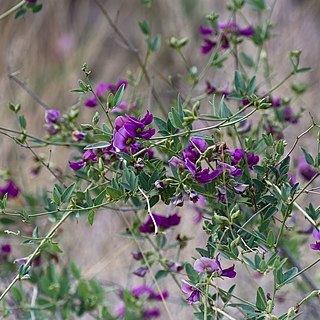A herb with trailing stems. These can be 2 m long. It can be a climber. The stems are hairy. The leaves have leaflets 1.3-10 cm long by 0.4-3.5 cm wide. The our rounded or wedge shaped at the base and oval and tapering at the tip. The flowers can be pink or blue and have a sweet scent. The fruit are pods 5-12 cm long by 5-8 mm wide. The seeds are dark brown and 9 mm by 5.5 mm,
Leaflets 1.3–10 × 0.35–3.5 cm, lanceolate or narrowly triangular to ovate, apiculate at the apex, broadly cuneate to rounded at the base, glabrous above, with scattered hairs beneath; petiole (2)5–15 mm long; rhachis 2–17 mm long; stipules 7 × 1.5 mm, narrowly attenuate, the spur 5 mm long; stipels 5 mm long, subulate.
Corolla variously described as pink and mauve or blue, violet or red with the base of standard inside pale green or yellow and greenish-yellow or whitish outside; standard 2.2 × 2.4 cm; wings c. 1.8 cm long, spathulate, much narrowed at the base with a distinct spur 3 mm long, decurrent on to the claw.
Flowers sweet-scented, (1)2–4(5); peduncle 1.5–18.5 cm long; pedicels 7–12 mm long; bracts 2.5–3.5 × 0.8–1.2 mm; bracteoles 4–6 × 1–1.8 mm, lanceolate.
Perennial plant of varying habit, with trailing stems to 2 m long, a climber 1–3 m tall or a wiry spindly subshrub to 1 m tall; stems hairy.
Calyx tube 5–7 mm long; calyx lobes 6–9 × 2–3.5 mm, triangular to lanceolate, the lowest the longest; upper lip up to 5 mm wide.
Seeds dark blackish-brown, 8 × 5.5 × 5.5 mm; hilum 0.8 mm long.
Pods 5–12 cm × 5–8 mm.

